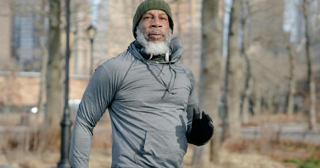
Susan was always active. She walked daily, took the stairs instead of the elevator, and lifted light weights at home. But one day, after a simple stumble in the kitchen, she fractured her wrist. That’s when her doctor gave her a diagnosis she never expected: osteoporosis.
At first, she was afraid not to move too much, asking, “What if something else breaks?” But a conversation with her physiotherapist changed everything. She learned the right kind of strength training could protect her bones, not weaken them.
If you’ve been diagnosed with osteoporosis or low bone density, you might be hesitant to stay active. But here’s the truth: sitting still is far riskier than moving, when you do it safely. Strength training is, in fact, one of the best ways to protect your bones. According to the Mayo Clinic, strength and weight-bearing exercises are key to maintaining bone density and reducing fracture risk.
What Is Osteoporosis?
Osteoporosis is when your bones become thinner, weaker, and more likely to break. It happens when the body loses bone faster than it can build it. It’s common, especially with age, and often has no symptoms until a fracture occurs. The most common areas affected are the spine, hips, wrists, and ribs.
But here’s the good news: bones are living tissue. That means it can get stronger when you challenge it in safe, controlled ways.
Why Strength Training Matters for Bone Health
When your muscles pull on your bones during movement, your bones respond by building density. This is called mechanical loading, and the more consistent the challenge, the better the response.
Here’s why strength training is helpful if you have osteoporosis:
- It improves bone strength, especially in the spine and hips
- It builds muscle, which supports your joints and reduces falls
- It improves balance and posture, lowering your risk of injury
- It increases confidence to move without fear
Not all exercises are safe for everyone with osteoporosis. That’s where a physiotherapist comes in.
How Physiotherapists Create Safe Strength Programs
Everyone’s body is different, especially when it comes to bone health. A physiotherapist takes the time to understand your posture, strength, balance, and mobility. Then they build a personalized plan that’s gentle, progressive, and tailored just for you.
Here’s what that might look like:
1. Starting With Safe Basics
At first, exercises are just simple, safe movements to get your body working:
- Wall push-ups
- Sit-to-stands from a chair
- Step-ups on a low stair
- Standing heel raises
These exercises activate the muscles that protect your bones, especially around your hips, thighs, and core. I stumbled across a really great guide written by a physiotherapist, called “Best Workouts for Individuals with Osteoporosis”. Check it out
2. Use Resistance Carefully
Resistance bands, hand weights, or body weight are often used, depending on your comfort and bone status. A physiotherapist will guide:
- How much weight to start with
- When to increase reps or resistance
- Which movements to avoid, like deep spinal twists or loaded forward bends
We aim to build strength safely and gradually.
3. Target High-Risk Areas
Some bones are more vulnerable than others, so a good program puts extra attention on:
- Spine: Exercises to support posture and reduce slouching
- Hips: Lunges or side steps to strengthen the hip and pelvic area
- Core: Gentle core strengthening to improve stability and support your back
These areas are most likely to fracture in people with osteoporosis, so protecting them is key.
4. Add Balance Training
Falls are one of the biggest risks with osteoporosis, so balance work is essential:
- Standing on one leg (with support at first)
- Heel-to-toe walking
- Gentle lunges with a hand on a counter or chair
Even five minutes daily can help you feel steadier and more in control.
A Few Exercises That Are Often Recommended
Here are some common osteoporosis-safe strength training exercises (always check with a physiotherapist before starting):
- Wall push-ups: Build upper body strength
- Chair squats: Improve leg strength and stability
- Standing hip abductions: Strengthen hips and glutes
- Resistance band rows: Build back muscles and support posture
- Bird dog (on hands and knees): Gently activate the core and spine
Every movement is chosen with your safety and progress in mind.
Final Thoughts
Susan started with 10-minute strength sessions twice a week. But with time and guidance, she felt stronger, more balanced, and less afraid to move. A few months later, her follow-up bone scan indicated improvement.
If you’ve been diagnosed with osteoporosis, remember: you’re not fragile. With the right support and movement plan, your body can get stronger.
Strength training with a physiotherapist isn’t about “bulking up”. It’s about protecting your bones, staying independent, and enjoying movement again.
If you have questions or want to book an initial consult, call us at either of our locations:
Seattle in the Laurelhurst neighborhood – (206) 402-5483
Or our Mountlake Terrace clinic – (425) 582-8845

